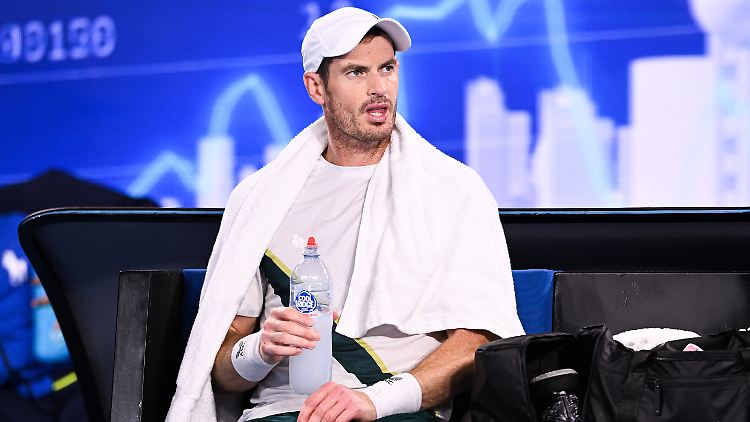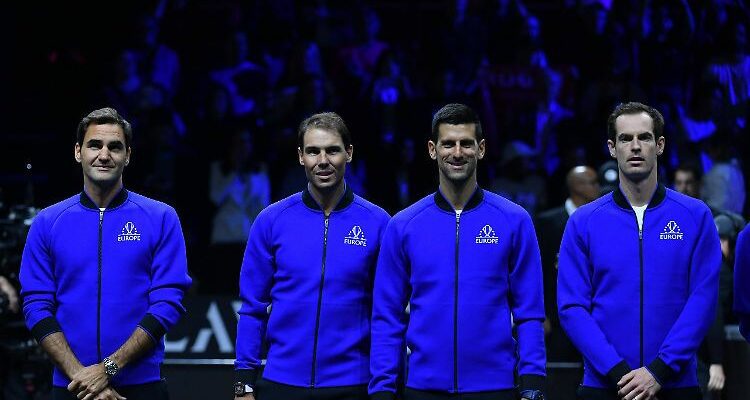Mentality monster, metal hips, Andy Murray: The Briton, who was almost retired, wins the next epic marathon match. His pain can be heard at the Australian Open as he reminds the world of his special strength. However, Murray’s wife has to decide on one thing.
He hits his sharpest counterattack after five hours and 45 minutes of play. On-court interviewer John Fitzgerald asks Andy Murray how he turned this incredible tennis marathon into the history books in his favor. “I don’t know how I did it,” the 35-year-old stammers in a post-match interview. “It’s incredible that I was able to pull this together. I’ve played better the longer the match has gone on. And, yeah, I have a big heart.” When Fitzgerald then replies with “I think everything about you is great”, the Brit hits out coldly: “I’m not sure if my wife would agree with that.”
Joking late at night. After almost six hours of fireworks tennis. Incomprehensible. Murray and the Australian Thanasi Kokkinakis duel at the Australian Open until the morning and end up fighting against the opponent and exhaustion in the second round match until the Brit finally won 4: 6, 6: 7 (4), 7th place :6 (5), 6:3, 7:5 win the game ended at 4:05. The match is surpassed in length only by another at Melbourne Park – the 2012 Australian Open final between Novak Djokovic and Rafael Nadal, which lasted five hours and 53 minutes.
Both players deserve the highest respect for the top-class game, the marathon of pain. The fans, who loudly remain in the arena until morning, let them feel and, above all, hear it at all times. Roar and cheer again and again ecstatically because of the unbelievable fight up to the last second. Murray is celebrated almost as frenetically as the local Kokkinakis.
What amazes the fans, and what makes the match a historic match in Melbourne history books, is a series of long and incredibly competitive rallies. The entire game. The tension peaks early in the third set as Kokkinakis, who won the first two sets, takes a 2-0 lead while fending off three break points.
Murray scares away tennis ghosts
But Murray doesn’t give up. Never. Because the Brit’s greatest strength is not his incredible running work, his still great feeling for the ball on the net, or his match management, i.e. his ability to feel the game and thus dictate it: Murray’s advantage over so many other world-class professionals is his unconditional will. His toughness. His staying power. His mental toughness.
He defeats even the nastiest demons that regularly haunt tennis players in such a best-of-five game. Insidiously nesting in their skulls. When they are lonely on the court against themselves and – felt – fighting the rest of the world. When suddenly nothing seems to work anymore. When the head kicks in and hums a dangerous mantra: “You’re not good enough!”, “You can’t beat that one over there!”, “It’s over!” Not with Murray. Against Kokkinakis, the Brit, who is known for his five-set qualities, proves again and again how he scares these ghosts away with his irrepressible will. Without this strength, Murray would never have been able to fight his way back from his serious injuries. But more on that in a moment.
Back to the third set. After Kokkinakis saved three break points, Murray somehow managed to deflect four consecutive smash attempts to regain control of the point – and eventually win the third set in the tiebreak – in this nerve-wracking game.
In the fourth round Murray is the better, almost seems to have fallen into a fountain of youth and never loses energy. The last set is again, as it should be, very balanced and incredibly exciting for ten games. In a service game by Kokkinakis, Murray leads 40-0 and still cannot break the Australian. The audience freaks out. A short time later, however, the Briton uses his eighth break chance in this set with a forehand winner to lead 6: 5. He clenches his fist.
Murray competed with the triumvirate
With a backhand winner on his own serve, Murray finally makes the marathon victory perfect. There follows a heartfelt hug with Kokkinakis at the net – both get along very well off the court – and a primal scream for the history books. In the end, the Brit is behind in almost all categories. Except for the points won, where he leads with 196 to 192.
Federer, Nadal, Djokovic and Murray. Here saying goodbye to Federer in autumn 2022.
(Photo: IMAGO/PanoramaC)
Tonight, the world can witness what could have been. This generation has been blessed with the three most successful, and perhaps greatest, tennis players of all time. Federer, Nadal, Djokovic. But some have forgotten that there was even talk of the “Big 4” for a while. Because only one was able to play at the top for a certain period of time during the decades of the unbelievable triumvirate dominance: Andy Murray.
Sure, Stan Wawrinka swayed Djokovic and Juan Martín del Potro here and there Federer. And in modern times, the young wild ones around Alexander Zverev, Carlos Alcaraz, Dominic Thiem or Casper Ruud dare to step forward. But in the end, the old stars often win, even if Federer has resigned in the meantime, or someone who hadn’t won anything before. Only with Murray was there serious competition for the three Maestros for years to come. He coaxed three Grand Slam titles from them in their absolute wedding. Again and again he reached finals at Grand Slams. In Melbourne he is five times runner-up, losing four times in the final against Djokovic and once against Federer.
Who knows what would have happened if the injuries hadn’t interfered. Ah, the injuries. Every athlete can sing a song about it, of course. But Murray has written, recorded and sung entire operas about it. His medical record is an aria of pain. In January 2017, the Brit was knighted as the world number one for his services to tennis and charitable causes. Then it goes downhill. An elbow injury follows in March, until he retires with a hip injury two days before the US Open in August of the same year.
Return with metal hip
In January of the following year, Murray is also unable to play the Australian Open and undergoes a first hip operation. In July 2018 he withdrew from Wimbledon one day before the tournament “with a heavy heart” because it was still too early to play five-set matches. He falls back to 839 in the ATP rankings, his lowest ranking since he was first included in the ATP rankings on July 21, 2003. In January 2019, the Briton tearfully announced that he may be retiring from professional tennis because he had to struggle physically “for a long time”. The second hip operation follows a few months later. This time a metal hip is implanted.

When Murray wasn’t chasing his opponent across the court, he was drinking water, lots of water.
(Photo: picture alliance / AA)
Then Murray actually returns to the tour. Plays, even wins sometimes. Although persistent pelvic problems slow him down again and again, the mentality monster even fights its way into the quarterfinals in doubles at the Olympic Games in Tokyo 2021 – and now into the third round in Melbourne.
Murray didn’t just have pain in the marathon against Kokkinakis. He hurts audibly. With every movement, with every sprint, with every turn of his metal hips, the Briton groans loudly. Towards the end he can hardly walk between the points. Hobbles crookedly across the court. Then he chases the felt ball into every corner of the court like a possessed man. He drinks a total of seven 1-liter bottles of water and an electrolyte drink throughout the match. At 26, Kokkinakis is almost a decade younger than Murray, who is playing the longest match of his career tonight and winning for the eleventh time from a two-set deficit.
He may have won the first two sets a round earlier, but the tournament’s first five-set win over Matteo Berrettini, seeded 13th in Melbourne, is just as incredible. After all, the Italian is considered one of the new stars in the tennis sky. Doesn’t matter. Old-school Murray is showing what’s still in him too, with his first win over a top-20 player in a Grand Slam since 2017.
Bad times for demons
“In the last few years I’ve certainly questioned myself sometimes. There were certainly a lot of people who doubted me and my abilities, whether I could still keep up with the biggest events and the biggest matches,” says the 35-year-old after the more than four and a half hour fight. “After the match I was very proud of myself. That’s something I haven’t always felt at the end of tennis matches in recent years.” All in all, Murray has been on the blue court for more than ten hours this year. Some people have already reached the quarter-finals in Melbourne. For Murray it’s enough for the second round. Crazy.
After two marathons, especially after the Kokkinakis match until the wee hours – Murray won’t be in bed until 7am local time – recovery is as important as it is complicated. This gives his opponent in round three, Pablo Carreño Busta, a real advantage. Murray putting on a third such show? Unlikely. The second in a row was actually far too unrealistic to be true.
But who knows. Anything seems possible for Metal Murray at the moment. But it doesn’t matter what he shows in the next round. The Briton proved once again why he was the only one who could really challenge the Big 3. That he can still bring any opponent to their knees with fight, endurance and incredible mental strength. The demons on the pitch anyway. Bad times for tennis ghosts.
